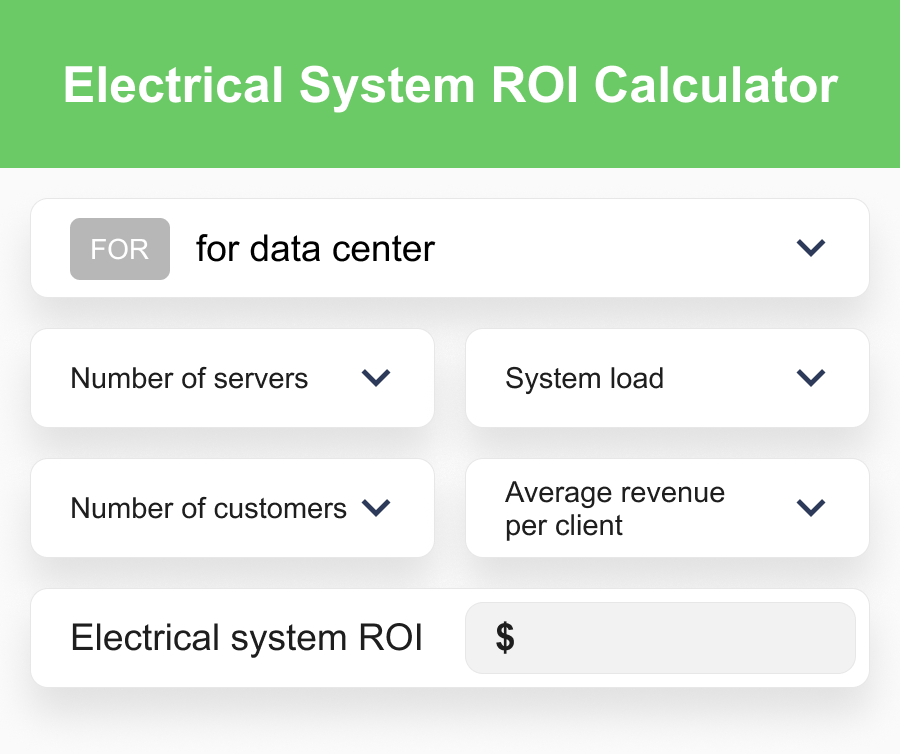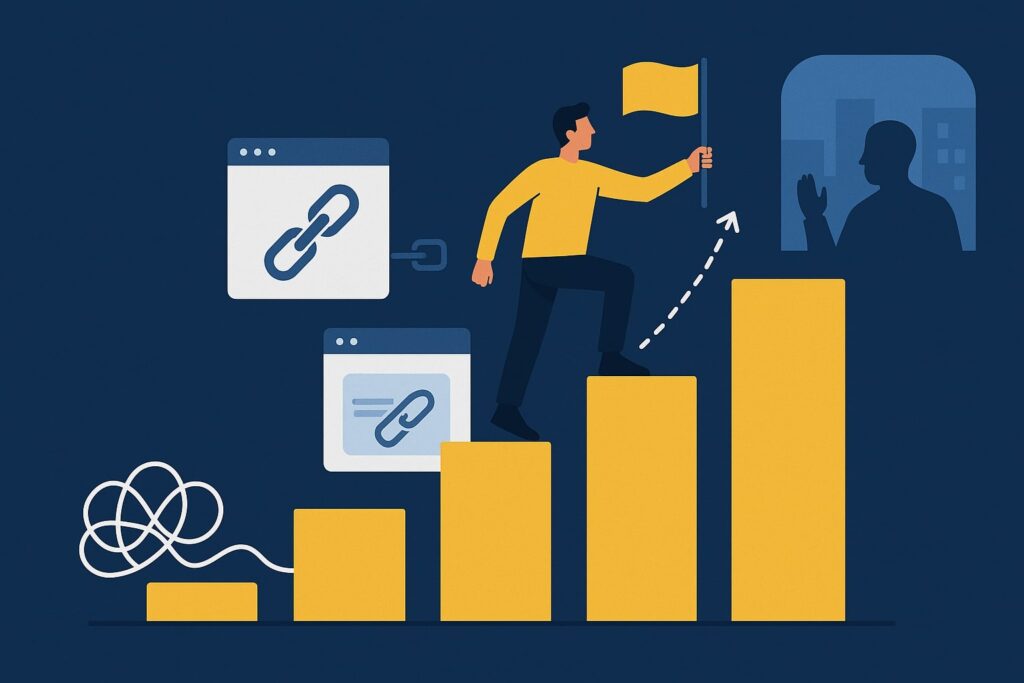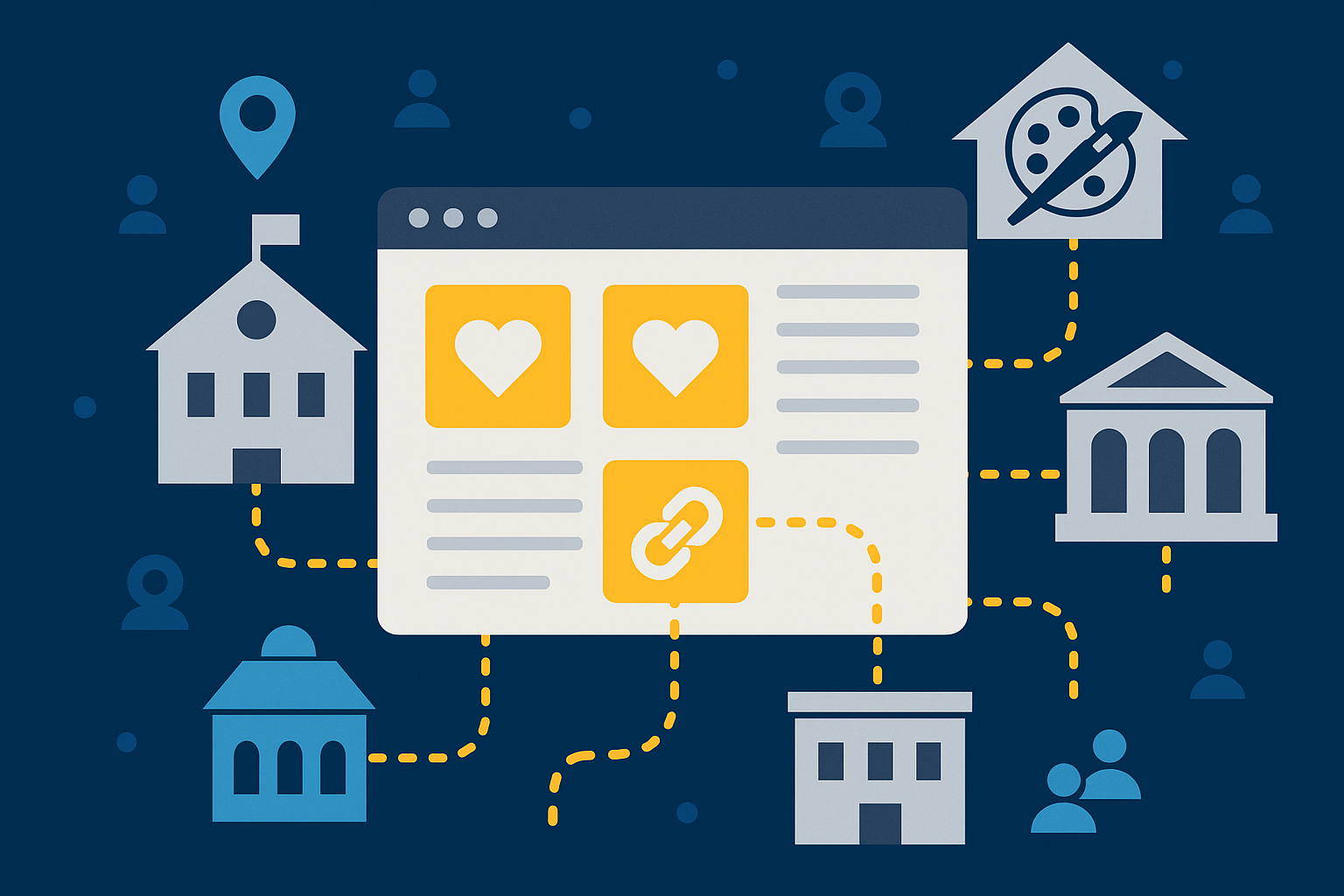Citable elements enable ANY page on your website to function effectively as a target page in a link building campaign. Citable elements enable you to focus link building resources on pages that will more quickly provide ROI – your sales pages.
And even if you’re unable to actually add citable elements to a page, the brainstorming process forces you to consider the full spectrum of audience personas – ALL the decision participants, not just the buyer. Thinking fully about these “stakeholders of an offering’s benefit” often produces new concepts for workable link building campaigns that will drive commercial keyword rankings.
Sample Citable Element
For reference, here’s a sample citable element we created for a webpage that sells Panelboards, Switchboards and Switchgear. We’re suggesting this element – an ROI calculator – be added directly onto a category page for electrical systems equipment.
By adding this element to the page, we can effectively conduct an entire link building campaign and earn enough links to get the page ranking competitively.
How did we arrive at this specific element? Here’s our brainstorm of possible citable elements for a page that sells Panelboards, Switchboards and and Switchgear. Notice that the citable elements – in section b – are just one part of the larger campaign.
Target Stakeholder: Business/Organizational Visionaries (board, CEO + advisors, leadership team). The people who decided to construct a fully functional data center, hospital, office, etc…
- Offering-Specific Challenges:
- Justifying cost of key facility systems to financial stakeholders.
- Ensuring the facility’s key functionality – uptime, steady production, etc.
- Effectively communicating construction slowdowns, hold ups and other unexpected events
- Reducing Lifetime Cost of Ownership: Disaster Preparedness, Insurance, Electric Costs
- Applied Expertise (as Onpage Citable Elements):
- Calculator showing bottom-line impact of the electrical system on Data Centers, Hospitals, Offices, etc…
- “Plain English” communication advice for discussing most-common issues or hang ups within electrical systems installations.
- Audience-Facing Publishers:
- Business leadership publications.
- Data center, hospital, office park, commercial construction/engineering trade publications.
- Websites/blogs of electrical systems designers and installers.
- Websites/blogs of construction, engineering, architecture and other systems-design firms.
- Websites/blogs of commercial insurance agencies
- Campaign Concepts:
- “The Big Pitch: Communicating the Value of Key Systems in Vital Facility Construction Projects”
- “Common Pitfalls to Getting Facility Construction Done On Time and Under Budget”
- Reducing the Lifetime Cost of Facility Maintenance and Repair
Once the element is published to the page, the link team can begin outreach to the audience facing publishers, pitching content for placement similar to that listed under “Campaign Concepts.”
Here’s a high level summary of citable elements, to better frame your understanding of the individual components so you can begin brainstorming citable elements for your sales pages link building campaigns.
Citable Elements, at a Glance:
- Typically created for web pages that are:
- designed for sales conversions
- not conventionally “linkable”
- ranking poorly due to a link gap vs competitors
- Embedded, informational content sections, with anchor or jump links for easy navigation, on the sales page you’re targeting for links
- Speak to one or more of the “benefit stakeholders,” that is, the people who directly or indirectly benefit from the offering for sale on the page
- Contain or summarize useful information or guidance for a very specific audience
- Audience MUST be a “stakeholder” of the offering’s benefit, though not always a direct beneficiary
- Audience MUST be targeted by web publishers with how-to, data-driven and/or trend information
- You can add citable elements for multiple audiences
- Be sure that you’ve added citable elements for enough stakeholder audiences that you’ll be able to close your link gaps
- Useful information must also relate to the context of the offering’s benefit – where, when, how and/or why the stakeholder benefits
- Content must derive from unique expertise, findings, research of the company
That’s our overview of exactly what citable elements are.
Now here’s how we go about developing citable elements, which begins with thoroughly thinking through the various purchase decision influencers for the offering.
Citable Element Discovery Process Looks Like This:
- Going Beyond the Buyer Persona – Make a List of Benefit Stakeholders:
- Learn who are the most-frequent nay-sayers in a purchase decision for this offering?
- Learn who are the users of the offering – are they different from the buyers?
- Learn who benefits from the offering, and how – are these people different from the buyers and/or users? Do they have distinct roles within the organization?
- Learn who is harmed if and when the offering fails, breaks, is not used, or is not used properly
- Learn about implementation/getting-started challenges – is the implementer the same as the buyer?
- With Your New List of Benefit Stakeholders:
- Learn if there are trade-specific publications, events, shows, etc for them
- If so, how many?
- Learn if there are non-competing vendors who also target each specific stakeholder
- If so, how many?
- Sort your stakeholder list by volume of publishers who target them
- Know Your Link Gap
- Knowing your page’s approximate link gap tells you how many citable elements you may need for a page
- Each citable element, assuming it targets a different stakeholder, enables campaigns that speak to different/distinct publishers
- Knowing how many links you need will help you work backwards into which stakeholders make the most sense to approach (based on the volume of publishers who target those stakeholders)
- Brainstorm Information that Would Maximize Stakeholder’s Benefit
- What information would enable your selected stakeholder to maximize the benefit of your offering?
- How can you help your selected stakeholder overcome context-specific challenges relating to your offering?
- Promote Your Citable Elements
- Write content that cites your citable elements.
- Discover existing content that could be better supported by your citable elements. Pitch.
No one said building links to sales pages was easy – in fact, it would be much easier to figure out how to build links to an entirely new piece of content that happens to target what we call “linker valued audiences.” But links to your resource content doesn’t consistently or reliably support rankings of your sales pages. Don’t stop writing and promoting link-worthy content though, but remember that the greatest impact and ROI happens when building links to your sales pages.
Key Concepts/Glossary:
- The Offering:
- Any single product or service that’s for sale from a page on your website.
- Can entail a CATEGORY of offerings as well, again with reference to specific page on your website.
- Offering’s Benefits:
- At the item-level we mean very specifically the offering’s benefits.
- At the category-level we mean more generally, how that category creates benefit.
- Benefit Stakeholders
- Because sales pages are often written (rightfully) for buyers, they often neglect the wider array of stakeholders who benefit from the offering itself. It’s these neglected stakeholders whose information needs dictate our citable elements.
- For example, while “Business Leaders” are not the people directly purchasing Panelboards, they DO benefit from the Panelboards within the new data center they’ve authorized to build.
- Purchase Decision Stakeholders
- Sometimes the person making the purchase decision does not benefit directly from the purchase. In the hunt for link opportunities, it can make sense to brainstorm ALL of the people involved in or impacted by the purchase decision. Then you can develop citable elements for those who are targeted by offsite publishers.
- Citability
- Citability implies that a bit of information is worthy of citing, sharing or otherwise linking to by an offsite web publisher. This would mean it adds value or credibility to the offsite publisher’s guidance to their audience. Further, because it’s unique to the page, it creates a justifiable citation.
- Link Gap:
- Average gap in root linking domains between your page and the other pages that rank for your target keywords
Resources for Further Exploration
Citable elements not only make your pages more linkable but also help you focus efforts on those that deliver measurable results. These resources might help you refine your strategy:
- ROI Google Sheet Template: A simple tool to evaluate the potential impact of campaigns centered around citable elements and ROI-focused pages. Access it here.
- Link Launch Tool: A practical resource for organizing and executing link-building campaigns that prioritize high-value targets. Try it here.
- Explore More: Check out additional insights and strategies from our blog to deepen your understanding of link building. Explore here.




